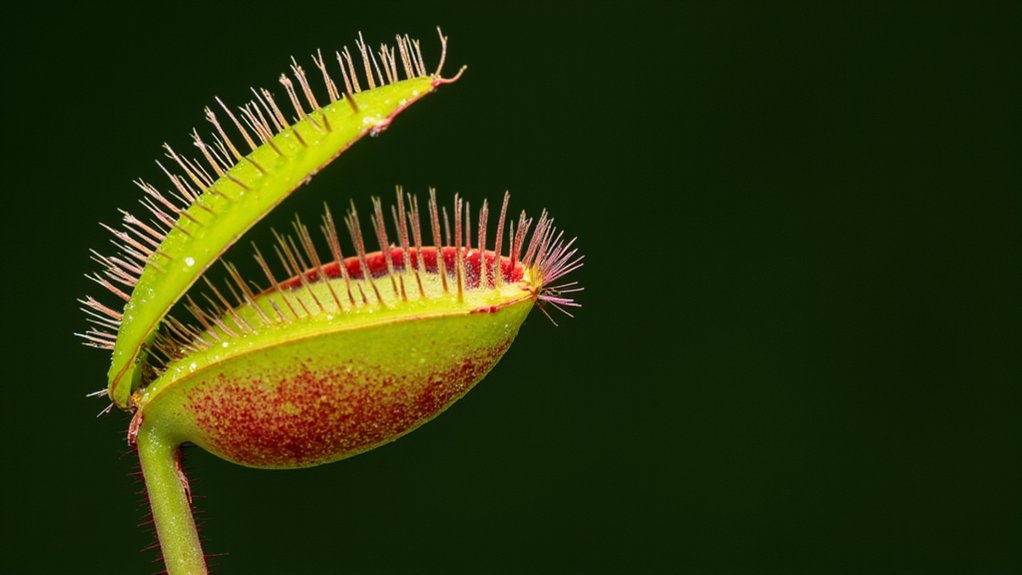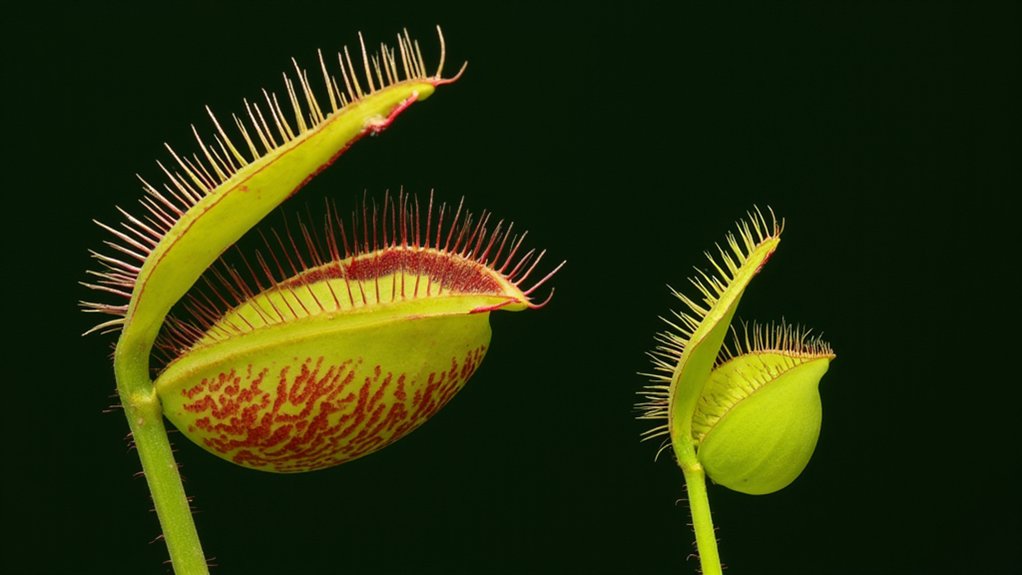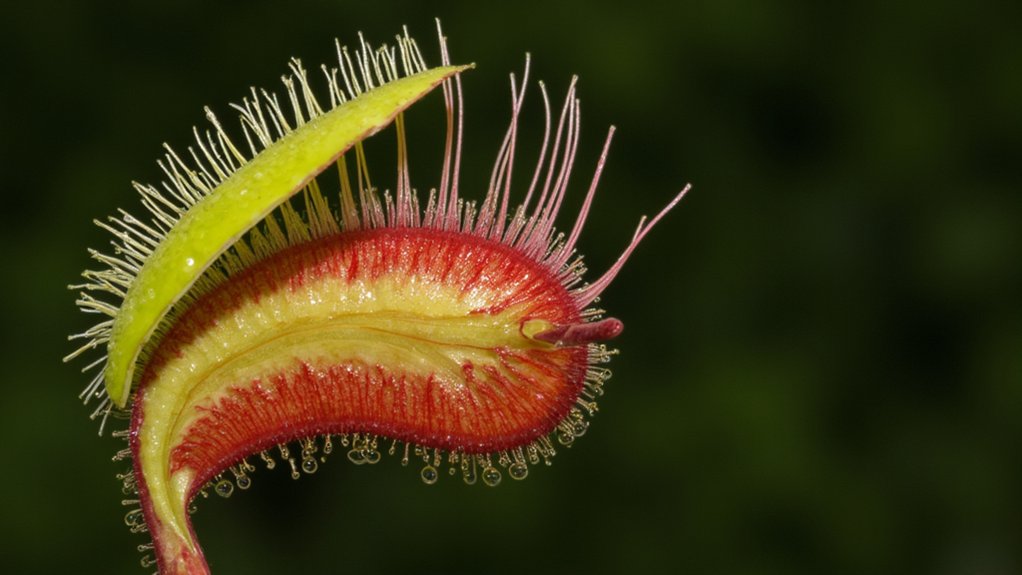You might be surprised to learn that Venus flytraps can count to five and possess a basic form of memory. These remarkable carnivorous plants won’t just snap shut at the first touch – they require specific timing and multiple triggers before committing to a catch. While their jaws can close in under 100 milliseconds, the intricate system behind this swift action involves complex electrical signals, specialized trigger hairs, and precise ion movements that rival some animal nervous systems.
Contents
- 1 The Evolution of Nature’s Snap Trap
- 2 Anatomy of the Venus Flytrap’s Deadly Jaws
- 3 Trigger Hairs: The Plant’s Sensory System
- 4 Electrical Signals and Memory in Plants
- 5 The Two-Touch Rule: Why Timing Matters
- 6 Chemical Reactions Behind the Snap
- 7 Digestion Process and Nutrient Absorption
- 8 Environmental Factors Affecting Trap Function
- 9 Energy Conservation and Hunting Strategy
- 10 Research Breakthroughs in Plant Intelligence
The Evolution of Nature’s Snap Trap

Although the Venus flytrap’s snap-shut mechanism seems like it could’ve emerged overnight, this remarkable plant actually evolved over millions of years from a common sundew ancestor. You’ll find the evidence in its DNA, which shows a gradual transformation from flat sticky leaves to hinged traps.
The process began roughly 70 million years ago, when its ancestors developed tiny molecular sensors in their leaves. These sensors eventually evolved into the trigger hairs you see today. Through natural selection, the leaves slowly curled inward, creating the distinctive lobes that make Venus flytraps such efficient insect catchers.
Anatomy of the Venus Flytrap’s Deadly Jaws

The Venus flytrap’s remarkable snapping mechanism comes down to a specialized set of modified leaves. These hinged lobes form the distinctive “mouth” of the trap, lined with sensitive trigger hairs and sharp, interlocking teeth-like projections along the edges.
You’ll find each lobe contains three hair-like sensors that, when touched, trigger an electrical signal through the plant’s tissue. The inner surface features specialized glands that’ll secrete digestive enzymes once prey is caught.
The trap’s outer surface contains tiny cells called motor cells that rapidly change shape when activated, causing the lobes to snap shut in less than one-tenth of a second.
Trigger Hairs: The Plant’s Sensory System

Inside each Venus flytrap’s deadly lobes, you’ll find specialized trigger hairs that form an intricate sensory network, acting like microscopic trip wires for unsuspecting prey. These sensitive bristles, typically 2-3 millimeters long, can detect even the slightest touch or vibration from small insects.
When an unfortunate bug touches two trigger hairs within 20 seconds, or the same hair twice rapidly, it sends an electrical signal through the plant’s tissue. This signal, similar to your nerve impulses, triggers a rapid change in the trap’s cells, causing them to release water and snap shut in less than one-tenth of a second.
Electrical Signals and Memory in Plants
Similar to neurons firing in your brain, Venus flytraps generate measurable electrical impulses that travel through their cellular networks. When you touch a trigger hair, it creates an action potential, sending an electrical charge through the plant’s tissues at a speed of 20 centimeters per second.
What’s fascinating is that the plant can actually count these electrical signals. It needs two touches within 20-30 seconds to close its trap, demonstrating a basic form of short-term memory. This counting mechanism helps prevent the plant from wasting energy on false alarms, like raindrops or debris, ensuring it only snaps shut for potential meals.
The Two-Touch Rule: Why Timing Matters
While Venus flytraps can sense a single touch, they’ve evolved to require two distinct trigger hair stimulations within a precise 20-30 second window before snapping shut. This clever adaptation helps prevent the plant from wasting energy on non-prey items, like falling leaves or raindrops.
If you were to touch one trigger hair, you’d trigger an electrical signal that primes the trap. The plant then starts its internal timer, waiting for a second touch to confirm potential prey. Without that second touch in time, the trap resets. It’s nature’s way of ensuring the plant only snaps shut when there’s a high probability of catching nutritious prey.
Chemical Reactions Behind the Snap
Once the Venus flytrap receives two trigger signals, a cascade of chemical reactions springs into action. Inside the trap’s cells, calcium ions flood through special channels, triggering electrical signals that race across the leaf’s surface at speeds up to 20 centimeters per second.
This electrical surge prompts the release of water from specialized cells, called motor cells, through a process known as osmosis. You’ll find these motor cells on the outer surface of the trap, and when they rapidly lose water, they contract. The sudden change in cell pressure causes the trap’s lobes to snap shut in less than one-tenth of a second.
Digestion Process and Nutrient Absorption
The trapped insect’s fate unfolds through a remarkable five-day digestion process. Once sealed inside, you’ll find the trap filling with digestive enzymes that break down the prey into a nutrient-rich soup.
The plant’s glands secrete acids and enzymes, similar to your stomach’s digestive juices, dissolving the insect’s soft tissues. You can observe how the trap’s inner walls absorb nitrogen, phosphorus, and other essential minerals from this liquid mixture.
After completing digestion, the trap reopens, leaving only the insect’s exoskeleton behind. The Venus flytrap’s digestive system can process prey up to one-third of its own size.
Environmental Factors Affecting Trap Function
Since Venus flytraps thrive in specific conditions, you’ll need to understand how environmental factors impact their trap mechanisms. Temperature plays an essential role, with traps functioning best between 70-95°F (21-35°C). Below 50°F (10°C), the traps become sluggish and may not close properly.
Light intensity affects trap sensitivity, as these plants need 6-12 hours of direct sunlight daily. In low-light conditions, you’ll notice slower trigger responses and weaker closure force.
Humidity levels around 50-70% guarantee ideal trap flexibility. When it’s too dry, the sensitive trigger hairs can become brittle and unresponsive, while excessive moisture may cause trap rot.
Energy Conservation and Hunting Strategy
Because Venus flytraps expend significant energy to close their traps, they’ve evolved remarkable strategies to conserve resources. They’ll only snap shut when they’ve detected multiple trigger hair activations within 20-30 seconds, ensuring they’re not wasting energy on false alarms.
You’ll find that these plants are surprisingly selective hunters. They’ve developed a counting mechanism that requires at least two distinct touches to their trigger hairs. This prevents them from closing on raindrops or debris, and you can observe how they’ll digest their prey for 5-12 days before reopening, making the most of each successful capture.
Research Breakthroughs in Plant Intelligence
Recent scientific discoveries have transformed our understanding of Venus flytrap intelligence. You’ll find that these plants can actually count electrical impulses, requiring two trigger-hair stimulations within 20 seconds to close their traps. They’ll even wait for five stimulations before releasing digestive enzymes.
Scientists at the University of Wisconsin have mapped the plant’s electrical signaling system, revealing how calcium waves spread through trap leaves at speeds of 10 centimeters per second. You can observe this sophisticated mechanism yourself using specialized imaging equipment that detects bioelectric signals, showing how these plants process information without a brain.
